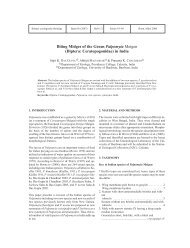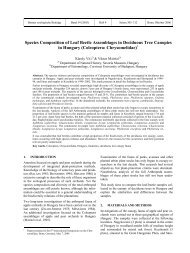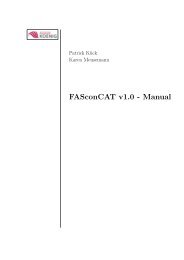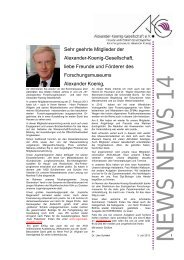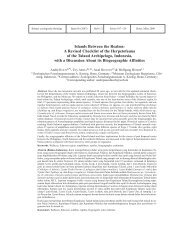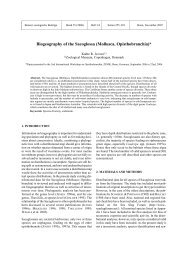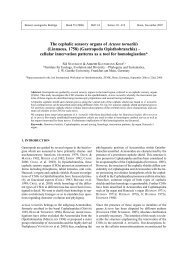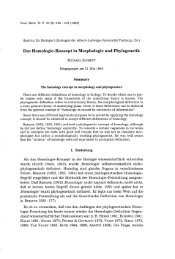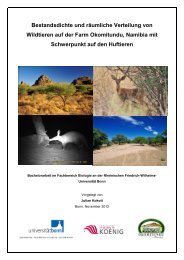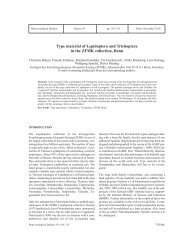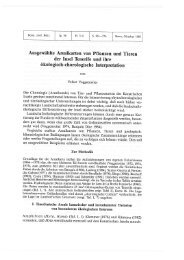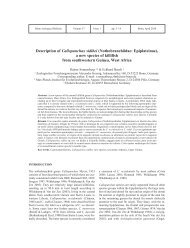Successful Husbandry and First Breeding of Varanus juxtindicus ...
Successful Husbandry and First Breeding of Varanus juxtindicus ...
Successful Husbandry and First Breeding of Varanus juxtindicus ...
Create successful ePaper yourself
Turn your PDF publications into a flip-book with our unique Google optimized e-Paper software.
112<br />
WESIAK AND KOCH - HUSBANDRY AND BREEDING OF VARANUS JUXTINDICUS<br />
<strong>and</strong> olfactory traces. In addition, it is recommended to<br />
wait until the monitors are completely at ease. This took<br />
about 10 minutes each time.<br />
The high energy dem<strong>and</strong> <strong>of</strong> the monitors could<br />
not be met by feedings only insects. High quality food<br />
with adequate calorie content had to be provided. In<br />
addition to large insects, subadult mice <strong>and</strong> rats, boiled<br />
eggs, crabs, <strong>and</strong> saltwater fish were provided two to<br />
three times per week. Despite the daily UV exposure,<br />
it was necessary to enhance the food with vitamins <strong>and</strong><br />
mineral supplements. Biweekly, higher-concentrated<br />
multivitamin doses (Multi Mulsin® from Mucos<br />
Pharma, now discontinued) were provided. The dose<br />
<strong>of</strong> the supplements used should be 600 I.E. for vitamin<br />
A <strong>and</strong> 100 I.E. for vitamin D 3 per kg/body mass <strong>and</strong><br />
week. The calculation <strong>of</strong> vitamin D 3 dose has priority if<br />
the concentration <strong>of</strong> both vitaminsare not balanced (G.<br />
Köhler, pers. comm.).<br />
Reproduction in Captivity<br />
After two months, first copulations were observed<br />
between 30 March 1991 <strong>and</strong> 6 April 1991 (Fig. 11). The<br />
female only mated with the smaller male which always<br />
alternated use <strong>of</strong> both hemipenes. While approaching,<br />
the male regularly bit the female’s neck which in some<br />
cases was quite fierce. To date, this behavior has not been<br />
observed in any other monitor species kept by KW.<br />
Matings always followed the above described<br />
behaviors. The mean time span between the last mating<br />
<strong>and</strong> oviposition was 40 days. The female regularly<br />
frequented a sunken box with removable cover to deposit<br />
the clutches. The female’s tendency to eat the eggs after<br />
deposition persisted. Even the decision, from January<br />
1995 onwards, to induce oviposition by the application<br />
<strong>of</strong> Oxitocin® (3 I.E/kg body mass intramuscular [Köhler<br />
1996]), could not solve this problem. The number <strong>of</strong><br />
eaten eggs was always verified by the partly digested<br />
eggs in the female’s feces (see Fig. 13).<br />
The first eggs were laid on 15 May 1991 (Fig. 12).<br />
Immediately after deposition (Fig. 8) the female ate<br />
three <strong>of</strong> the four eggs (Fig. 13). The fourth egg proved<br />
to be unfertilized when incubated artificially. By April<br />
1993, the female had deposited two further clutches<br />
(29 October 1992 <strong>and</strong> 18 January 1993) which only<br />
contained five <strong>and</strong> six unfertilized eggs, respectively.<br />
Between April 1993 <strong>and</strong> April 1995, the female laid<br />
another seven clutches. In total, 54 eggs were deposited<br />
(<strong>of</strong> which 24 were eaten) with ten fertilized eggs, eight <strong>of</strong><br />
which were successfully incubated. Initially, Vermiculite<br />
was used as substrate, but was switched to Perlite for later<br />
clutches due to its looser grain. However, no advantage<br />
was recognized.<br />
The first V. <strong>juxtindicus</strong> hatched in captivity on 28<br />
September 1993 (Figs.14 to 16). All eight hatchlings,<br />
without exception, opened <strong>and</strong> left their eggs<br />
independently. A summary <strong>of</strong> the fertilized clutches<br />
between 1993 <strong>and</strong> 1995 (denoted as I to VII) <strong>and</strong> data<br />
on the first phase <strong>of</strong> live juveniles are provided in Table<br />
1.<br />
Fig. 11. Mating <strong>of</strong> the small male <strong>and</strong> the female V.<br />
<strong>juxtindicus</strong>. Photograph by Klaus Wesiak.<br />
Fig. 12. Clutch <strong>of</strong> four eggs <strong>of</strong> V. <strong>juxtindicus</strong>; below an<br />
unfertilized egg. Photograph by Klaus Wesiak.<br />
Fig. 13. Partly digested eggs from the feces <strong>of</strong> the<br />
female. Photograph by Klaus Wesiak.




